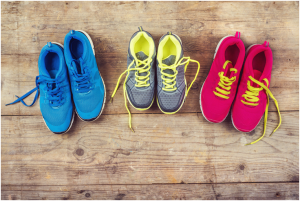
19 Dec Tips for the Perfect Running Shoe
There’s more to running than running. There’s shoes. When you are getting to the pointy end of races and comps, dialing in on your main piece of gear can make or break your tootsies. So let’s talk shoes.
As each person’s gait and foot strike is different, it will depend on how you gallop when it comes to choosing your shoe. Grab your runners and see where you’re wearing them.


Pronation shows a wear pattern centralized to the ball of the foot and a small portion of the heel. It is the foot’s natural inward roll following the heel striking the ground.
Basic (neutral) pronation helps absorb impact, relieving pressure on knees and joints. It is a normal trait of neutral, biomechanically efficient runners.
Overpronation is identified by wear patterns along the inside edge of your shoe, and is an exaggerated form of the foot’s natural inward roll. Overpronation is a common trait that affects the majority of runners, leaving them at risk of knee pain and injury. Overpronators need stability or motion control shoes. Stability shoes are good for runners who exhibit mild to moderate overpronation. They often include a firm “post” to reinforce the arch side of each midsole, an area highly impacted by overpronation.
Supination (also called under-pronation) is marked by wear along the outer edge of your shoe. It is an outward rolling of the foot resulting in insufficient impact reduction at landing. Relatively few runners supinate, but those who do need shoes with plenty of cushioning and flexibility.
Barefoot/minimalist running: In traditional running shoes, feet tend to hit the ground heel first. This is because a shoe heel has an elevated cushion. With barefoot runners, it is the midfoot or forefoot that strikes the ground first. Soles for this type of running provide the bare minimum in protection from potential hazards on the ground.
Many have no cushion in the heel pad and a very thin layer—as little as 3–4mm—of shoe between your skin and the ground. All barefoot shoes feature a “zero drop” from heel to toe. (“Drop” is the difference between the height of the heel and the height of the toe.) This encourages a midfoot or forefoot strike. Traditional running shoes, by contrast, feature a 10–12mm drop from the heel to the toe and offer more heel cushioning.
Finally, a few pointers if you are in the market of some new shoes.
Foot size: Shoe lasts (which determine shoe sizes) vary by manufacturer and even from one shoe model to another. You may need a half-size or even a full size smaller or larger than you think. If you’re unsure, have your feet measured.
Try on shoes at the end of the day. Your feet normally swell a bit during the day’s activities and will be at their largest then. This helps you avoid buying shoes that are too small.
Aim for a thumbnail’s length of extra space in the toe box. The width should be snug but allow a bit of room for your foot to move without rubbing. Laces should be snug but not tight. Barefoot shoes are an exception: Heel and toes should “fit like a glove” without any extra space in the toes.
If you wear orthotics, bring them along. They impact the fit of a shoe.
Got your feet sorted? Now you can focus on getting out there and getting amongst it!
I am no expert. So I consulted one and found most of this information at the REI website; Expert Advice: How to Choose Running Shoes



No Comments